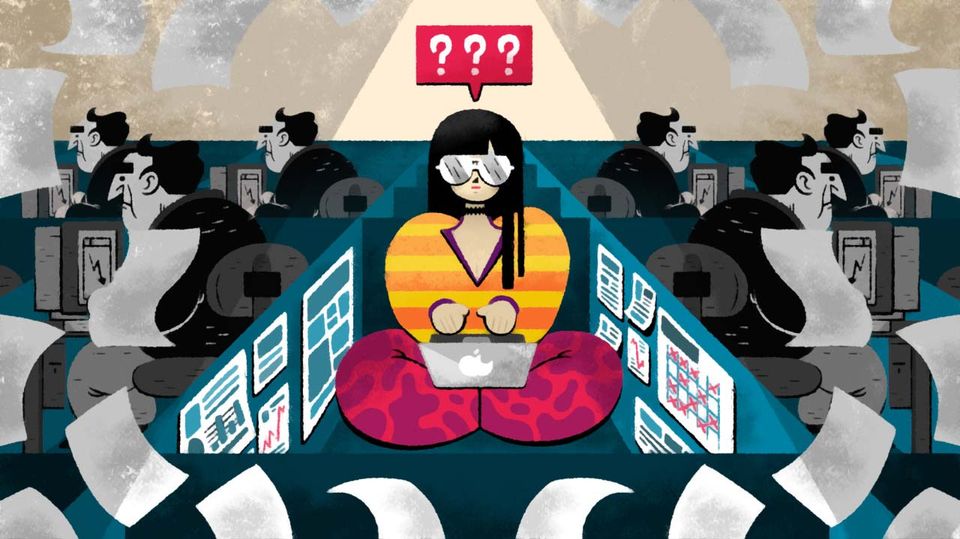Artist Spotlight: Dennie Bright
Website Editor • February 26, 2020
Everyone’s work is deeply idiosyncratic: in our regular Spotlight segment we explore artists’ experiences and inspiration to understand what defines and inspires their unique styles.
Can you give us a brief background on yourself?
I learned pretty early in my life that I conveyed my self best through imagery and drawing. I would almost always get flustered trying to explain something and just end up saying, “Let me just draw you what I’m trying to say.” I went to the Huntington School of Fine Art during my high school days and ended up going to The School of The Art Institute of Chicago for college. I studied Animation and Illustration, mostly 3D, but after college I fell back into 2D and mostly illustration. I’ve done work for The Huffington Post, Mashable, and currently I’m venturing into VR illustration at my own studio TwoThumbs. I tried VR a couple years ago, and since then it’s completely grabbed ahold of me.
What kind of influence does your location have on your career?
Being in New York you see so many different people while commuting. Everyone is so different and I constantly find myself thinking, I need to draw this person, or use their style on a character design I’m trying to develop. Everything’s constantly changing here too, so there’s some place new to always explore and things to experience.

What is your greatest source of inspiration?
Disney and Looney Tunes. Most people my age had cable television growing up, so they were exposed to Nickelodeon really early. All I had was old VHS tapes of really classic Disney and Looney Tunes cartoons. I would just watch the same ones over and over. Nothing beats a classic cartoon smear.
Could you pick one piece of art that has made a lasting influence on you, and if so why?
The animated short Destino, which is Disney & Salvador Dali's piece that was finished in 2003. I love the abstract and surrealness of Dali's paintings, and the animated short is like watching his work come to life. I rewatch it every now and then, it always inspires me to push the limits of what I can think and do.
What skills or techniques do you find most useful in your line of work? Do you use primarily traditional or digital methods to create your artwork?
In my experience the more you learn, the different mediums and styles, the better you will grow as an artist. Traditional work helped me when moving over to a digital medium, and having actually done sculpture, helped me when I wanted to learn sculpting in 3D. My advice is to never say no, and always try to learn as much as you can. Be a jack of all trades and a master at them too.
Can you give our readers a tip or trick you have come across that has made your work a lot easier?
It's not so much a tip or trick as it is a mantra that you should live by, "Draw every day." If you want to grow and become a better artist, keeping up with your craft and drawing each day will make you that much better. Figure drawing also helped me a lot with working with a time limit and drawing from life.
How can people who are interested in discovering more of your work find it?
You can find me at
twitter: twitter.com/denniebright
facebook: facebook.com/dennie.bright
instagram: instagram.com/dennie.bright
linkedin: linkedin.com/in/denniebright
and on my website: denniebright.com
Scriba is a revolutionary digital stylus that is ergonomically designed to comfortably fit your hand and uses unique Squeeze-Motion technology. Order here.
Articles

The United Nations has described the disruption to education caused by the pandemic as ‘unparalleled’. At the virus’ worldwide peak in April, it is estimated that over 90% of all enrolled learners, from kindergarten to bachelors and beyond, had their education affected by school closures and the pandemic (UNESCO). For many university students and older children, they have had to adapt quickly to online learning. They can keep in touch with their peers and teachers online and continue their studies, albeit in a highly modified way. As challenging as this may be, this experience will help equip them for a future that is increasingly online. For parents of younger children, they are assuming a new role: their child’s home school teacher. This is in addition to their usual childcare and household duties, their work responsibilities and often emotional and financial worries caused by the pandemic. Stressful? Yes. The good, and somewhat surprising, news? The experts advise that you don’t teach your children - at least not in the way you might expect.

If the recent outbreak of Covid-19 has taught us anything, it's that many adults do not wash their hands effectively. It has never been more important that we support our children to develop good personal hygiene to keep themselves and our families safe. This seemingly easy task can be very difficult for children with fine motor skill difficulties. In this article, we explore some ideas to support your child with hand washing.

Lockdown has brought the digital future into the now. Online shopping, entertainment, education and more have moved from the periphery to the mainstream to, in many cases, the only option. With the necessity of social distancing looking to continue for many months, it appears that this rapid digital revolution is here to stay. This means that life as we know it, in most of its sectors, has changed forever. In order to survive, businesses are having to adapt rapidly, embrace technology and look to the future. Architecture is no exception. There has been a widespread adoption of technology and VR over the past few months in response to the lockdown across all of society. Elderly grandparents who were once resistant to adopt new technologies talk of “Zooming” and have started video chatting with their family members to combat loneliness. Art galleries that were once considered stuffy or pretentious are now pioneers in VR technology, with Google Art & Culture offering tours of London’s National Gallery or the Musee D’Orsay in Paris. These virtual tours deliver art in a dynamic new way that can be far more engaging than regular photos. Critics have applauded the panoramic and immersive views of gallery building and exhibitions which work well for rendering of 2 dimensional art, however impressions of sculpture is somewhat lacklustre. With VR technology, users can enjoy a truly immersive experience in the comforts, and safety, of their own home. The COVID-19 pandemic has served as an accelerant for the arts and entertainment industries to embrace VR.





